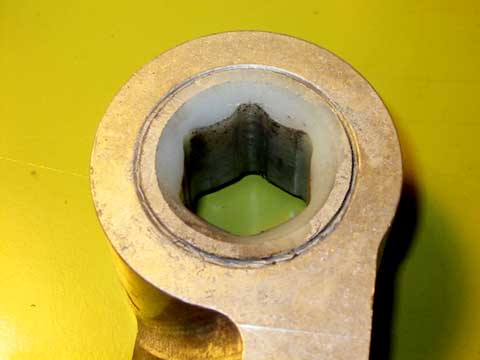Dealing with Treehouse Racing

I have tried various front lower control arms bushings during the ownership of the track car. From BMW OEM to Powerflex A to OE enhanced to Powerflex B back to BMW OEM then to TreeHouse Eyeballs and now back to BMW OEM again.
BMW OEM refers to what BMW dealers are selling.
Powerflex A refers to one of the earlier versions. The purple urethane failed on me on the race track. It slided out from the rest of the housing.
OE enhanced refers to what Bimmerworld sells as BMW OEM replacements but supposedly with slightly stronger and stiffer rubber.
Powerflex B refers to the updated version of Powerflex A. The updated urethane bushing has a metal plate molded in. It lasted for maybe 3 track days and still, the bushings failed on me.
Dismayed and frustrated, I searched all over to find the next best bushings in the market. The next stiffer material from urethane are bushings made with Delrin. Then beyond Delrin, we have spherical bearing bushings. As far as I recall, TC Kline and GC have the both for sale. Still, I wanted something that might close the gap between urethane and delrin.
Then I found TreeHouse Racing Eyeballs (THR). TreeHouse has been in the business selling a variety of modifications for E30 and E36. This is perhaps their first attempt at fabricating something for the E46. According to Jon S, owner of the company, the E46 Eyeballs bushings are made of a material similar to Delrin. Jon mentioned that they have sold quite a few and the product works great. With that in mind, I went ahead and ordered a pair back in late January 2007.

My first event to officially use the THR Eyeballs on the track was in March 2007. Five events later, the front of my car started making noises. The symptom was as such:
- While moving forward at about 5mph to 30mph, there will be a clunking sound every time the brakes are applied.
- The clunk sound is not heard when reversing and braking.
I consulted two of my buddies in the car business, Zolti from Technik Engineering and John from EMW. I related the symptom to both of them and both said the control arm bushings are to be blamed. But I was stubborn. Why? I firmly believed that THR will never manufacture a faulty product. Plus it is too early for the Eyeballs to fail. For $279 a pair, one would think that THR has to invest enough research, development and testing before selling the Eyeballs.
Being the fool I am, I went on to investigate everything but the THR Eyeballs, namely the front brakes, rebuilt the calipers, swapped the brake pads. Since we found some play in the control arms and we swapped them out with new ones. Still the clunk existed. Knowing I was about to pull out every single hair on my scalp, John lent me his Chassis Ears device. This is a device that is used to detect ambiguous noises in a car. It works as such: place the wireless sensors at locations where you suspect is the source of the noise, then use the main unit to amplify the noises detected through the sensors. A great product for a great situation like such. However, with several other projects on my mind, I gave up using the Chassis Ears and have John look into this instead.
And indeed, he found it. The bushings were replaced with OEM parts and the clunk went away.
So it turns out that the pseudo-Delrin material has failed. The internal dimensions have expanded, thus causing the ends of the control arms to wriggle inside. This explains the clunking sound. I called THR and Jon instructed me to send in the Eyeballs.
The Eyeballs were sent back to THR on July 16, 2007. Given a company like THR, one assumes that they must have a few extra bushings in stock. Two weeks later, after countless voice mails and requesting Robert (his assistant) to pass my message on to Jon, we finally spoke on the phone one rather bleak, lazy morning. And here are the facts:
- Jon did not return my calls because he had no updates for me.*
- Jon is not an engineer and he did not design the eyeballs.
- The Eyeballs are not fabricated in-house. They are outsourced and there is no definite lead time for the bushings.
- The pseudo-Delrin like material is in fact nylon. **
- Jon admitted that someone else using the same Eyeballs experienced something similar. Later on, he defended his product by posing a question “Do you know how many I have sold?” ***
- Jon refused a partial refund for the returned faulty Eyeballs.
*An unique customer service practice which I am still struggling to comprehend. During that time, my car was on the lift for two weeks and during which I missed a few track events. **According to Matweb, there are about 1000 different kinds of nylon. If he had used the glass-filled Nylon 66, maybe it will work. But remember Jon did not design these.
***Perhaps the most pointless question posed by him over the phone. It doesn't matter if THR has sold a million Eyeballs. Mine failed and that was all that it mattered.
As much as I would like the resolve the matter in a proper manner, the conversation ended on a rather awkward note, which I shall refrain from discussing here.